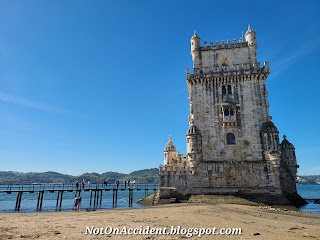 |
| Former convent that houses Parliament |
Our tour began with a drive just up the hill from our hotel to King Edward VII's Park where we enjoyed the view of the hills of Lisbon and out to the Tagus River (Rio Tejo). In 1903, King Edward VII of England came to Portugal to commemorate, and reaffirm, the political alliance between the two countries. Prior to that visit the 64 acre park was called Parque da Liberdade (Liberty Park). The huge statue (it's over 130ft tall) of Sebastião José de Carvalho e Melo, 1st Marquês de Pombal sits in the middle of the roundabout. He was a fascinating character and also the namesake of our hotel.
On All Saints Day (November ) in 1755, Lisbon experienced a devastating earthquake (Voltaire even wrote a poem about it). "The total number of persons killed included those who perished by drowning and in fires that burned throughout Lisbon for about six days following the shock." The Marquês de Pombal was a statesman, diplomat, and prime minister to King Joseph I, and following the disaster he took charge of the reconstruction. Amazingly, in less than a year the city was partially rebuilt and with the world's first earthquake-resistant buildings! He's also credited with creating the demarcated wine regions of Portugal (with the Douro Valley being the first in the world).
 |
| Calçada portuguesa pavement on Avenida da Liberdade |
Our next stop was the lovely Belém Tower from the 16th century, a fortification that was used as the beginning point and end point of the voyages of the Portuguese explorers. It was also often used as a ceremonial gateway to Lisbon. The Knights Templar were very powerful and wealthy at that time, and they had a hand in the voyages and discoveries made. You can see some of their insignias on the fortress (Templars cross, nautical knot, rope motif, etc.).
On to the Padrão dos Descobrimentos (Monument to the Discoverers), a stunning work that commemorates the 500th anniversary of the death of Henry the Navigator (discoverer of the Azores, Madeira, and Cape Verde). It stands 170ft tall and "is made up of a group of sculptures that represent the prow of a caravel (a small sailing ship constructed by the Portuguese to explore the Atlantic Ocean). Leading the ship is Prince Henry the Navigator and behind him are many other great Portuguese discoverers", including Vasco de Gama, Magellan, and Henry's mother.
We didn't have much time left over for exploring Sintra, but what I saw of the town was lovely.
Back in Lisbon, and off on my own, I headed to the oldest bookstore in the world. I'll admit I had high hopes, but was rather disappointed with the Livraria Bertrand. Had I realized it's now a nationwide bookstore chain I might have lowered my expectations a bit. Either way, it was established in 1732 and is recognized with a Guinness World Record.

References:
https://www.britannica.com/event/Lisbon-earthquake-of-1755
https://www.lisbon.net/monument-discoveries
https://www.jeronimosmonasterytickets.com/history/
https://www.tasteatlas.com/travesseiros and https://www.tasteatlas.com/queijada

















No comments:
Post a Comment